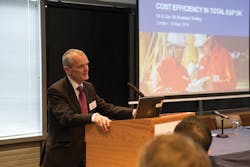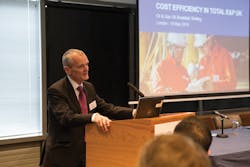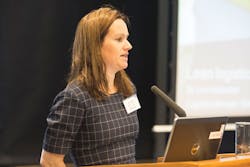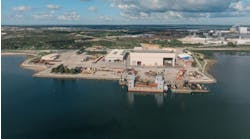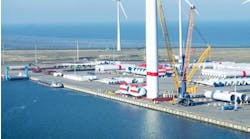Jeremy Beckman
Editor, Europe
Britain’s North Sea producers face a struggle to remain in business. The sector’s operating costs are among the world’s highest, with some of the older, higher-maintenance fields becoming a liability at the current oil price despite falling rig and service rates. At the same time, it is in the operators’ interest to keep their facilities running as long as possible to avoid sky-high decommissioning bills.
Oil & Gas UK’s Cost Efficiency conference in London in May outlined how operators and contractors on the shelf are managing the situation in different ways. Speakers included John Catlow, cost efficiency project manager at Total E&P UK, and Line Kaldestad, Statoil Production UK logistics manager.
Total operates three production hubs in the UK northern North Sea at the Alwyn and Dunbar fields, and at the Elgin/Franklin complex in the central UK sector. “We’re lucky we don’t have a large scatter of installations to deal with,” Catlow said, “so our operations are reasonably efficient.
“We’re still active, spending about £2 billion [$3.2 billion] this year. We employ a lot of people in the UK, over 1,000 at present, and we have a couple of major projects in execution. We’re nearing completion of the Laggan-Tormore [long-distance subsea-beach] development and the associated Shetland gas reception plant, and we recently launched the associated Edradour and Glenlivet [tie-in] project.”
Total is in a busy drilling period in UK waters, Catlow added, with two platform rigs in operation earlier in the year, later scaled back to one, and six mobile rigs at one point. These have been drilling a total of 10 development wells, two workovers and one exploratory well.
At the same time, the company is having to take on the major challenge of heavily reducing its costs, following a directive from headquarters in Paris to all Total divisions worldwide to deliver cash savings where possible to maintain profitability. “If we can manage an $8-billion cash improvement,” Catlow said, “that’s equivalent to $30/bbl.”
On the surface, the scope for savings appears limited in the UK operation, due to the difficulties of managing ageing infrastructure at Alwyn/Dunbar and complex high-pressure/high-temperature activity at Elgin Franklin, where operations were shut in for a long time following a leak in one of the wells.
“That’s not something you take risks with,” Catlow stressed.
The solution that Total is adopting is known as “Change Culture.”
“In our case, in the UK,” he explained, “the mantra for the past 10 years has been ‘be safe and produce.’ As long as you’re producing, the oil price is there to support you. Costs will be what they will be. But that attitude can’t continue – it’s not going to work on the UK continental shelf any more, and probably won’t in quite a lot of other areas of our industry. We’ve got to learn to be a little more competitive on costs – our engineers tend to engineer things and then worry about the costs later. And we have to deliver on our promises, which means delivering projects on time and also initiatives to save costs on time.”
Road map
Total initiated this program in March 2014 when the oil price was over $100/bbl. “When the price took a dive, we… had to add a layer to the project we had already launched,” Catlow said. “We’re reducing our capital investments, operating, and exploration costs, but we’re also trying to ensure projects in execution start up as quickly as possible. And we’re looking at the profitability of our assets…that is what’s really important for the longer term.”
The primary tool Total is using for this process is road mapping: In the UK, management has identified 77 initiatives for delivering cost improvements, ranging from less than $1 million to $10 million. “All our activities are under review,” Catlow explained. “That includes well construction, maintenance, field operations, geoscience, procurement, the way we execute projects, undertake our logistics spend, our information systems and our structural costs.”
At the time of this presentation in May, the road mapping exercise had been in operation in the UK for six months. “It’s led to lots of good ideas and enthusiasm,” Catlow said, “now we need to get on with it and deliver. As an example, our industry has a tendency to over-engineering, disparagingly referred to as ‘gold-plating.’ Our engineers will always try to deliver the best solutions that they can, but now they have to understand that the best technology solution may not be the one that’s going to fly for their business.
“Our drilling colleagues are very good at complexifying their wells, and our geoscientists are very good at making extremely complicated requests to our drillers,” Catlow said. “We then end up with expensive wells – so now we’re trying to strip out some of the costs in our wells.”
Total is proud of the technical standards it has established in its upstream projects, he continued, but sees scope for more flexibility. It is not always necessary for engineers to apply the same standards for upstream projects operating for 40 years to ones that are only likely to run for five to 10 years, he suggested.
The company has also implemented methodologies such as Six Sigma, which is designed to achieve improvements in a process via keywords, in this case: “define, measure, analyze, improve, control” – and “lean offshore” for its upstream operations. Offering an example, Catlow explained that Total geoscientists had been instructed to improve their planning related to seismic acquisition processing, while also being told to accept that they cannot always have all the data they would like. “It’s not an area we’ve paid much attention to, as wells tend to be where you spend the money,” he said.
Another area under scrutiny is information services (IS). “We have always gone for the best software for our geoscientists, the high-tech solution,” he explained. “Now we are going to look for more simple IS solutions for other items such as telecoms, even simple things, like printers.”
In addition, Total E&P UK is reviewing its leverage with the supply chain, and talking with its major suppliers about their sub-suppliers – “our own contract management is perhaps an area we’ve not been very good at,” Catlow admitted. The company is considering in some cases sourcing cheaper goods from China. “We’re also looking at stock optimization. Our drillers will always buy lots of pipe – then plans change, we end up not drilling the well, and the wretched pipe sits in the warehouse or yard for years and years.”
Where possible, the company is trying to collaborate more with other North Sea operators, offering time on its rigs for others looking for single well slots, and potential sharing of supply vessels. “It’s not easy when you have drilling operations to support, with [North Sea] rig costs at $3-400,000/d and supply boats costing $120,000/d. But if you have the option to go for an efficient rig or an inefficient supply vessel, it’s a no-brainer – you go for the latter.”
“We’re also looking at our annual offshore [platform-related] turnarounds and shutdowns – we’ve discussed with other operators whether we can align our activities, execute our shutdowns more efficiently,” he said. “Central to all this is communication – the case for change is being well made in the industry. We need to set expectations as to what we’re trying to achieve.”
Catlow concluded that the company had a strong position on the UK continental shelf, with three other production hubs, “so we’re not going out of business tomorrow. But we have to adapt to ensure that all our assets are profitable and continue to run that way in the long term. The focus is on cost reduction in the short term, but we’re also looking for long-term cost efficiency.”
Merger legacy
Statoil’s UK logistics head Line Kaldestad previously performed a similar role for the company in Norway. Following Statoil’s 2007 merger with its main Norwegian competitor Norsk Hydro, the company was operator of 26 producing assets offshore Norway with 10-12 drilling rigs operating at any time, she explained. It also presided over an expanded logistics infrastructure built up since the early 1980s, to an extent dictated by the Norwegian government’s desire to split the majority of the country’s offshore resources between two partially state-owned entities.
The two companies had four supply bases and three helicopter bases in the same areas in Norway. “It was not the best way to optimize our resources,” Kaldestad said. “Before the oil price plummeted [following the merger], we had looked for all our assets to increase production. So drilling/exploration activity was sky high, and the portfolio of maintenance and increased recovery projects required a lot of support and flexibility to achieve as many drilling meters as possible per day. That drove increased costs for installations, and we had a tremendous amount of storage vessels floating around as we lacked sufficient storage capacity offshore.”
But the situation was not sustainable. “We pressured the market,” she said, “which led to increased rates, and our costs continued to grow when the oil price fell. We then saw that we had to change our position and focus more on safety, but we also wondered whether there was anything we could do to…make our operations more cost-effective, use our resources better, and get more value for our money.” Thereafter, Statoil’s focus changed to getting planning right first time, she added, and ensuring the correct level of service for its activities.
“On the Norwegian continental shelf, we have a huge logistics operation,” she continued, “with seven supply bases and six helicopter terminals.” The company decided to optimize and re-organize its resources by examining its main costs drivers, starting with crew change capacity. Kaldestad cited offshore personnel based in Kristiansand requesting to fly out to offshore facilities and back the same day, or favoring crew changes between Tuesdays and Thursdays. “During these days, that meant we had to have additional [helicopter] capacity to get everyone offshore,” she said, so Statoil decided instead to spread flights throughout the week, insisting that staff accept longer layovers offshore or on their return to shore.
In any case, as drilling and exploration activity has dropped, the company’s requirement for staff offshore has fallen steeply, she pointed out. “Many of our modification projects have been canceled or postponed, and several of our installations…now operate with a lower persons on board capacity.”
As drilling has been scaled back, the company has reorganized its helicopter bases, transferring more resources from southern Norway father north, and entering an agreement with BP to operate helicopters jointly out of Sandnessjoen to trim costs. “We have also looked again at our contracts, many of which we entered into at a time of peak costs, so we don’t have the best rates,” she explained. Another major cost Statoil reviewed following the merger with Hydro was its fleet of platform supply vessels – the company had 40-60 operating at any time offshore Norway. “With seven supply bases, that didn’t give us a lot of opportunities to optimize,” Kaldestad said. “So in 2010, we launched a project to look at our bases, especially in the southern Norwegian North Sea, with a view to optimizing the structure without changing requirements in field development plans.” This led to Mongstad and Stavanger becoming the company’s main supply bases, with Aagostnes serving as a subsea mobilization base. Statoil also implemented a new regime to reduce the number of calls for vessels offshore to a more acceptable level, she added, “so that our teams get what they need when they need it, but they must get better at planning.”
Offshore Norway, operators must be able to provide emergency response resources from their own fleets, including search and rescue (S&R) helicopters and emergency response vessels. Statoil has responded by teaming up with other operators to provide area-wide emergency response, Kaldestad said. The company is also looking at restructuring its S&R capability more evenly, particularly in the southern sector, allocating three aircraft to the main field centers and a fourth to the Johan Sverdrup development. Many of the facilities are close to the UK North Sea median line, and Statoil is open to sharing its resources with operators in UK waters, she added.
When the company set up its operation in Aberdeen to support its Mariner field development (and eventually Bressay in the same area), “we took some of these learnings with us,” Kaldestad said, “to make sure that we have a sound set-up and that we don’t implement internal constraints on our operations that drive us to inefficiencies.” •
